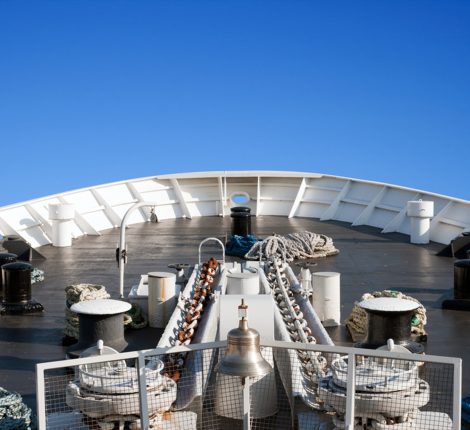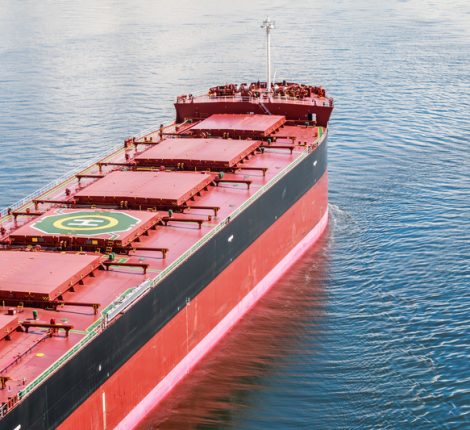- June 11, 2025
- 2025 , Circulars
- Comments : 0
Alert on Detainable Deficiencies
C25031 | 03 June 2025
Notice to: Ship Owners / Managers / Operators / Surveyors/ Auditors :
Following recent Port State Control (PSC) inspections, deficiencies were recorded that resulted in the detention of the vessels. Dromon wishes to draw attention to those deficiencies considered as ‘grounds for detention’ to avoid recurrence.
These detainable deficiencies, all of which contributed to detentions, were:
Structural Condition:
- The emergency generator 220V feeder panel earth gauge was reading near 0. The 440V and 110V diesel generator panels in the engine room were permanently showing alarms. A 110V panel earth gauge in the engine control room was faulty.
- Corrugated bulkheads between all cargo holds were holed in several places. The structural condition of the ship was generally substandard.
- Communication between the bridge and the steering gear room was insufficient.
- The base of the Derrick was corroded and holed.
- A bulkhead on the rescue boat deck was found holed.
- Many external decks were found with areas of high corrosion and holes.
- Water inlet from the rudder stock.
- Many brackets were found corroded on the main deck.
- Several spots of corrosion in the forepeak tank. Frames, longitudinal elements and brackets throughout the forepeak tank were holed/worn out.
- Structural members, e.g. frames, brackets, stiffeners and plates, are excessively thinned, blistered, cracked and corroded in the forepeak ballast tank.
- The structural members in the forepeak tank do not meet the last thickness measurement report requirements.
- Ballast tanks were holed (water leakage from side tanks to cargo hold).
Water/Weathertight Condition
- The engine room entrance door and the hold entrance doors were not watertight.
- The hatch coamings between cargo holds were cracked.
- Watertight doors to the fo’c’sle and CO2 room were not closing properly.
- Several ballast tank vents were found damaged/corroded; some FO tank vents were found corroded/damaged.
Emergency Systems
- There was no evidence that the free-fall lifeboat was launched at sea and manoeuvred every three months.
- The ballast water management plan was not available onboard.
- The steering gear room emergency lights were insufficient, and there was no emergency light in the passageway to the CO2 room.
- Several emergency lights in the open decks were found inoperative.
- The two-way radios malfunctioned, and one battery was not sufficiently charged.
- The emergency generator was not ready for auto start (air bottle empty).
- The emergency generator had only one means of starting and was found with leakages of cooling water and oils.
- One emergency light was missing on the main deck.
- The port and stbd side bulwarks adjacent to the drip trays were severely wasted and corroded, with holed plates observed at multiple locations.
Radio Communication
- The deck officers were not familiar with the operation of the GMDSS equipment.
Fire Safety
- A fire indicator light in the ER was found out of order. Numerous fire alarms in the accommodation were found to be inoperative.
- One nozzle of the sprinkler (water spray system) in the paint store was blocked.
- Smoke detectors in some crew cabins had been made inoperative by plastic covers.
- Some of the fire hoses tested were found holed. Water was leaking from the nozzles.
- The emergency fire pump was inoperative.
- Between the mess room and galley, one opening in the Class A bulkhead, for serving food, could not be closed properly.
- In one crew cabin, used as a store, the heat detector had been removed. In another crew cabin, the heat detector cover had been removed.
- The fireman’s protective suit could not be properly fastened. The fireman’s lifeline wasn’t fireproof.
- The engine room bilges contained a large amount of oily mixture.
- It was impossible to close the cable holes in the galley bulkhead. In the stairway enclosure, bulkheads had many holes, used for fastening self-closing fire doors open with wires.
- Stairwell fire doors were hooked to the bulkheads.
- Several self-closing class A fire doors were found hooked in the open position. The emergency generator’s self-closing door was found damaged.
- Several self-closing fire doors were found not to close properly. 2 galley self-closing fire doors fitted with unauthorized hold-back hooks.
- Fire doors in the galley, emergency exits in the engine room and the galley, were found damaged.
- The lower platform engine room escape door was damaged and did not close properly.
- The diesel emergency generator tank’s quick-closing valve was not directly fitted to the tank.
- Two fire hoses were found holed, and a main deck fire box was broken.
- The E/R Smoke detector was inoperative.
- The manually activated call point on the bridge was inoperative.
- The main and emergency fire pumps were not ready for remote starting.
- The emergency fire pump could not achieve the required test pressure.
- Remote means for closing ventilation in the emergency generator room were found disconnected.
- Engine room ventilation ducts on the main deck were found holed by corrosion.
- 7 of the 9 connections between the jacketed high-pressure lines and the fuel oil leakage alarm system were found to be incorrectly mounted.
- A fire damper in the separator room was found stuck in the closed position, the system for remote closing was missing.
- The fuel tank quick-closing devices were found out of order.
- A fire damper was found to be unable to be closed properly, and the ‘open/locked’ markings were not correct.
- A fire detection and alarm system push button alert was not maintained for Immediate use.
- Both main pumps (Fire/Bilge/Ballast and Fire/Gen. Serv) were leaking heavily during testing. The fire pump and the emergency fire pump couldn’t provide enough pressure to the fire hoses on the deck.
- There was no record of testing the E/R quick-closing valves.
- The fire detection panel was found inoperative.
- Two hydrants were leaking and with blocked valves, and three fire boxes were damaged.
Safety of Navigation
- The Compass observation logbook was missing. No compass errors had been determined.
- The responsible officer was not able to find the spare magnetic compass and stated that “it is not onboard”.
- The ship’s bell was missing.
- The passage plan was not berth to berth. There was no position fixing, including primary and secondary options, on arrival.
- The International Code of Signals was missing.
- With the main engine stopped, the bridge ME RPM counter indicated 300 rpm and the ECR counter indicated 50 rpm.
- Charts were found not updated and with missing parts of the voyage (waypoints, anchor points, route from anchor position to pilot station, route from pilot station to berth).
- One ECDIS chart for the previous voyage was missing, and one chart was not up-to-date.
- There was no certificate of compliance for the VDR.
- Nautical charts necessary for the intended next voyage were missing. Some voyage Charts were not updated.
- The main rudder indicator in the conning position and the bridgewing rudder indicators were not aligned.
- The last voyage plan was not berth-to-berth and was not signed by the master and officers.
- There were no nautical charts onboard for the intended voyage.
- Both previous and next voyage passage plans were incomplete due to the lack of some nautical charts.
- The light fixture foundations on the signalling light mast on the compass deck were loose and corroded.
- Admiralty Nautical Publications were not found onboard.
- The Admiralty List of Radio Signals, Volumes 2 & 4, were not the latest editions.
- An unofficial ECDIS (laptop) was found on the bridge.
- The Aldis Lamp was damaged
Life-saving Appliances
- Liferafts were found permanently lashed to the ship and with improperly secured hydrostatic release units.
- The free-fall lifeboat winch motor was of insufficient power.
- One immersion suit was found damaged.
- Both starboard and port side embarkation overboard lights were found inoperative.
- The lifeboat embarkation ladder was found damaged.
- In the open lifeboat, the compass and the orange sail were not stowed on board.
- One lifejacket was found with a retroreflective strip missing.
- Some lifebuoy lights were inoperative.
- There was no record of the lifeboat having been launched in the last three months.
- The lifeboat was not ready for use (battery empty).
- The lifeboat engine failed to start.
- The rescue boat engine was found not ready for use due to a lack of gasoline.
- The rescue boat davit was found highly corroded; safety pins were missing.
- Both port and starboard side embarkation ladders were damaged and in very poor condition.
- The rescue boat compass was not correctly stowed.
- All 4 line-throwing apparatus were found expired.
- The lifeboat air vents could not be closed from inside and were heavily corroded. The painter release device was heavily corroded and seized, the instructions were incorrect. The bottom plugs were not identified. The bilge pump was unable to pump out water from the bottom of the lifeboat.
- The davit launched liferaft capacity per the safety equipment certificate was 25 persons, but the liferaft on board was for 20 persons only.
ISM Code
- During the fire drill, the firemen were not familiar with the operation of the BA set. The face mask of one BA set was malfunctioning. The crew needed more training in fire drills.
- During the fire drill, the following were observed:
- The galley doors were not closed to insulate the area;
- The air pressure inside the one BA bottle was too low (approximately 60 bar);
- The firemen were unable to read the pressure inside the bottle.
- During the abandon ship drill, the following were observed:
- None of the crew members brought immersion suits;
- The officer in charge did not bring the EPIRB.
- During the fire drill in the galley, the crew were unable to undertake their duties and use the firefighting equipment properly (oxygen masks, helmets and BA straps were not properly donned). The working language was English, but communications were in Russian, which some of the crew did not understand.
- During the fire drill, the crew were unable to undertake their duties and use the fire-fighting equipment properly:
- Boundary cooling was not performed,
- The fire pump was not started,
- Quick-closing valves were not closed,
- BA sets were not properly donned,
- The two-way portable radiotelephone apparatus was not used,
- During the simulation of the release of CO2, the E/R skylight was left open,
- Considering the fire was affecting one of the auxiliary engines, nobody started the emergency generator,
- At least four crew members entered the place of the fire without any protection,
- One firefighter entered the vicinity of the fire with an empty BA bottle.
Certificates & Documentation – Crew
- One officer’s medical examination certificate was missing.
- The Medical examination certificate for one crew member had expired.
- Several crew members did not have valid SEAs.
- Some Deck Officers’ GMDSS flag state endorsements were missing.
- One Officer’s Flag state application had expired.
- One rating who was part of a navigational watch had no Certificate of Proficiency.
- One watchkeeping engine rating had no Certificate of Proficiency.
Certificates and Documentation – Ship
- The safety construction certificate, when checked by QR code, was found to be expired.
- The safety equipment certificate, when checked by QR code, was found to be expired.
- The ballast water management certificate when checked by QR code, was found to be expired.
- The IOPP certificate when checked by QR code, was found to be expired.
- The DOC when checked by QR code, was found to be invalid.
- The completion date of the cargo ship safety construction certificate survey was while the vessel was at anchor. According to the visitors’ logbook and crew declaration, nobody went onboard on that date.
- There was no risk assessment accompanying the Flag State Exemption for the malfunctioning speed log.
- The International Air Pollution Prevention Certificate did not include the R407C refrigerant used in the air conditioning system.
- The IOPP Supplement Certificate was missing.
- The Safety Management Certificate on board was a copy, not the original.
- No documentation onboard for last special survey (condition evaluation report, thickness measurements, etc.)
Certificates and Documentation – Documents
- The weekly LSA inspections were not recorded in the logbook.
- The Fire Safety Operational Booklet was missing.
Propulsion and Auxiliary Machinery
- The main engine had excessive fuel oil leakage from the fuel oil pump pipes.
- The auxiliary engines had excessive fuel leakage.
- Both diesel generators had excessive oil and water leakages.
- The oil mist detector was broken and disconnected.
- The ME cylinders’ injection pipes’ insulation was damaged, and there were no crankcase oil mist detectors or engine bearing temperature monitors or equivalent devices.
Pollution Prevention – MARPOL Annex I
- One sludge tank was found open with a portable pipe coming from the middle part of the E.R. for the transfer of dirty oil.
- An oil spill has been confirmed to have originated from the vessel entering the sea.
- The 15 ppm oil filtering equipment was inoperative.
Pollution Prevention – MARPOL Annex VI
- The ozone-depleting substances record book was missing.
Pollution Prevention – Ballast Water
- The Ballast Water Treatment System was out of order.
MLC, 2006 Conditions of employment
- Crew members had not received their wages for the past three months.
MLC, 2006 Accommodation, recreational facilities, food and catering
- The accommodation ventilation was not working properly. The crew stated that the air conditioning was out of order.
- There was not enough drink and food for all the crew members for the next voyage.
- There was no fruit, fresh vegetables, or fish available on board. The meat was not properly segregated, and the fridges were not hygienic.
- Several crew cabin bathrooms had no door handles, and there was no hot water. Taps, showers, and lavatories were broken.
- In some crew cabins beds were found not fixed, desk and chairs were missing, clothes lockers missing handles and closed by screw driver, and missing drawers.
- The air conditioning system, even though in working condition, was found partially dismounted.
- There was water leakage in several cabins, causing the risk of electrical short circuits and rot.
- Showers needed maintenance; one sink was inoperative, toilet doors in some cabins were found damaged; hot water was not available in the sinks in all cabins, public toilet needed maintenance.
- Crew toilets were in a poor condition (flushing water system malfunctioning, sink drain pipe missing, dirty).
MLC, 2006 Health protection, medical care, social security
- Protection from moving mechanical parts was missing from the diesel generators.
- MGO leakages were apparent from the boiler’s fuel line.
- There were minor fuel oil leakages on the main generator.
Act now
Surveyors / Auditors should take note of the above detainable deficiencies and pay special attention during forthcoming class and statutory surveys and audits, irrespective of scope.





